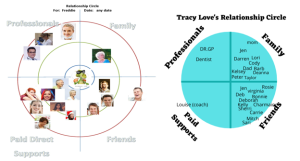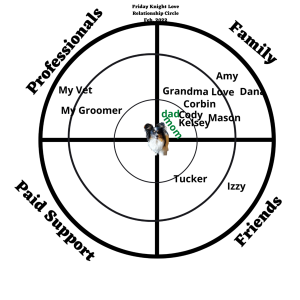Chapter 3: The Relationship Circle
Here are a few important questions you should consider when personalizing a plan for a person you are supporting:
- Who are the most important people in your life?
- How often do you spend time with them?
- What do you do together?
One way to facilitate this conversation is to develop a Relationship Circle with the person.
Watch this video to find out more about Relationship Circles.
Download Relationship Circles – Transcript Word Doc [14.5 KB]
The Relationship Circle template below is one example of how you could develop and record a relationship circle. Click on the purple (+) icon to find out more information on each section. The people who are closest to the middle of the circle within each quadrant should be considered for the focus persons one page profile under the section entitled: “What matters to me / What’s important to me’.
Watch this video of Damian and his support reviewing his relationship circle.
Note that the circle does not need to be designed in quadrants; however, discussing it in quadrants helps ensure we don’t miss anyone. Quadrants also help to identify when someone’s relationships may be off balance.
Download Damian’s relationship circle – Transcript Word Doc [15.9KB]
Answer the following questions based off the video of Damian’s relationship circle.
For the images below, compare the two relationship maps and answer the following reflection question. These relationship maps are for two different people and are done in two different ways.

![]()
Knowledge Debrief
Please complete the 4 questions in the quiz question set.
Below are example templates (Microsoft Word, Microsoft PowerPoint & Canva) for a circle relationship map.
You can select and access the circle relationship templates down below to create your own, following the steps for the person centered plan task.
![]()
Person Centered Plan Task
- Meet with your chosen focus person and create a Relationship Circle with them. Remember to include all of the important people in their life. You can personalize the circle to have quadrants that are applicable to them. For example, if they do not have paid support, maybe co-workers or co-students would be a better quadrant.
- Use colours, fonts, and images that make it personal to the person.
- Add very important people identified on the circle to the focus person’s One Page Profile.
- Ask these questions: a) Is there anyone you want to see more of? b) Is there anyone you have not been in contact with for a while with whom you want to reconnect?
- Add notes for actions. These will be considered for goals in the person’s goal section of their Person-Centered Plan.
- See the example of Friday Knights Relationship Circle below.


